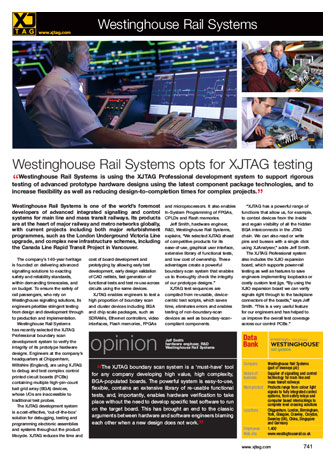Westinghouse Rail Systems is using the XJTAG Professional development system to support rigorous testing of advanced prototype hardware designs using the latest component package technologies, and to increase flexibility as well as reducing design-to-completion times for complex projects.
Westinghouse Rail Systems is one of the world’s foremost developers of advanced integrated signalling and control systems for main line and mass transit railways. Its products are at the heart of major railway and metro networks globally, with current projects including both major refurbishment programmes, such as the London Underground Victoria Line upgrade, and complex new infrastructure schemes, including the Canada Line Rapid Transit Project in Vancouver.
The company’s 140-year heritage is founded on delivering advanced signalling solutions to exacting safety and reliability standards, within demanding timescales, and on budget. To ensure the safety of rail passengers, who rely on Westinghouse signalling solutions, its engineers prioritise stringent testing from design and development through to production and implementation.
Westinghouse Rail Systems has recently selected the XJTAG Professional boundary scan development system to verify the integrity of its prototype hardware designs. Engineers at the company’s headquarters at Chippenham, Wiltshire (England), are using XJTAG to debug and test complex control printed circuit boards (PCBs) containing multiple high-pin-count ball grid array (BGA) devices, whose I/Os are inaccessible to traditional test probes.
The XJTAG development system is a cost-effective, ‘out-of-the-box’ solution for debugging, testing and programming electronic assemblies and systems throughout the product lifecycle. XJTAG reduces the time and cost of board development and prototyping by allowing early test development, early design validation of CAD netlists, fast generation of functional tests and test re-use across circuits using the same devices.
XJTAG enables engineers to test a high proportion of boundary scan and cluster devices including BGA and chip scale packages, such as SDRAMs, Ethernet controllers, video interfaces, Flash memories, FPGAs and microprocessors. It also enables In-System Programming of FPGAs, CPLDs and Flash memories.
Jeff Smith, hardware engineer, R&D, Westinghouse Rail Systems, explains, “We selected XJTAG ahead of competitive products for its ease-of-use, graphical user interface, extensive library of functional tests, and low cost of ownership. These advantages create a powerful boundary scan system that enables us to thoroughly check the integrity of our prototype designs”.
XJTAG test sequences are compiled from re-usable, device-centric test scripts, which saves time, eliminates errors and enables testing of non-boundary-scan devices as well as boundary-scan-compliant components.
“XJTAG has a powerful range of functions that allow us, for example, to control devices from the inside and regain visibility of all the hidden BGA interconnects in the JTAG chain. We can also read or write pins and busses with a single click using XJAnalyser”, adds Jeff Smith.
The XJTAG Professional system also includes the XJIO expansion board, which supports power-rail testing as well as features to save engineers implementing loopbacks or costly custom test jigs. “By using the XJIO expansion board we can verify signals right through to the backplane connectors of the boards”, says Jeff Smith. “This is a very useful feature for our engineers and has helped to us improve the overall test coverage across our control PCBs.”







